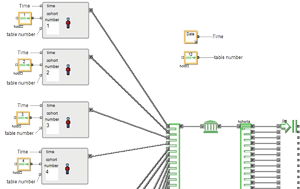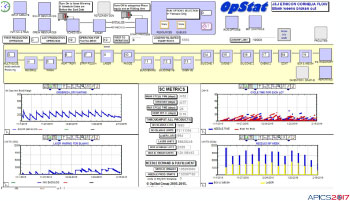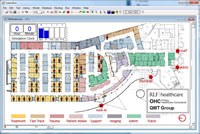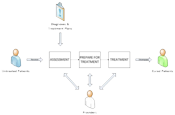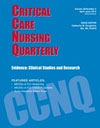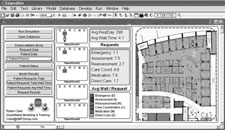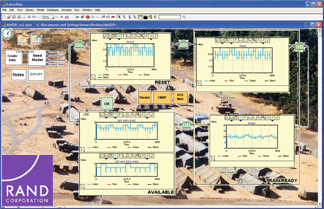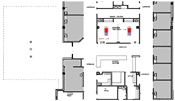In the search for better methods to understand healthcare systems and develop solid, credible, evidence-based answers to complex questions, mathematical modeling has stepped up to the challenge.
Simulation gives healthcare professionals the freedom to make mistakes and to learn from them without the need for intervention by experts to stop patient harm. By seeing the outcome of their mistakes, learners gain powerful insight into the consequences of their actions and the need to “get it right”.
A research team at the University of Southern California developed a system that models nanoscale drug delivery through the bloodstream. It simulates the flow of nanorobots through the bloodstream until they detect cancer cells, at which point they maneuver to the tumor and begin the process of drug delivery. This topic is impractical to test for in the lab, due to the difficulty of introducing different planes of different materials to a human immune system without endangering anyone in the process.
How could we expedite vaccination distribution to protect society if there’s a pandemic? In a February 2017 report published in the Disaster Medicine and Public Health Preparedness journal, ExtendSim was used to quantify the potential of integrating retail pharmacies into pandemic vaccine response planning. Model results indicated the weekly national vaccine administration capacity increased to 25 million doses per week supporting efforts to achieve a projected 80% vaccination coverage of a single dose of vaccine per person when retail pharmacies are integrated into pandemic vaccine response planning.
California Department of Corrections and Rehabilitation (CDCR) houses over 170,000 inmates in 33 adult prisons so it can be challenging to provide timely access to healthcare services while ensuring the safety of staff and inmates. Using ExtendSim, a prison medical program was modeled addressing the full continuum of healthcare services. After running over 350 different scenarios, five specific recommendations were made that improved the percent of inmates completing medical processing within six hours from 36% to 91% achieving the goals of the CDCR.
Clinic
Redesign
Using ExtendSim, a consultant was able to save their client approximately $415,000 annually by streamlining their processes and staffing requirements as well as proposing a redesign of their outpatient clinic. By identifying the best use of excess capacity, over $2.5M in additional revenues were recognized. Plus, the ExtendSim model showed the new clinic could accommodate up to 30% more patients, adding $1.5M in new services.
ExtendSim in Healthcare
 Design and planning of emergency departments.
Design and planning of emergency departments.- Test new procedures and dosage requirements for dangerous drugs and help manage chronic diseases.
- Healthcare informatics and diagnostics.
- Drug delivery.
 Evaluate current and proposed processes to improve patient flow, reduce costs, and increase patient satisfaction.
Evaluate current and proposed processes to improve patient flow, reduce costs, and increase patient satisfaction.- Innovate new ways and means of comprehensive healthcare.
- Pharma solutions.
- Optimize flow patterns and capacity utilization when building new or extended facilities.
- Recommend changes to corporate standards regarding staff levels and panel sizes.
- Resource prioritization and allocation in the short and long term when faced with projected increases in clients and the need to expand without over-expanding.
- Telephone answering for a large medical practice.
- Dementia strategy.
- Simulation of the function and operation of neural networks.
- Acute and psychiatric hospital bed provision.
- Clinical trial designs.
Who is Using ExtendSim
 ExtendSim was used for a landmark healthcare study in which two major healthcare organizations used RFID to track nurses at 38 hospitals across the country. The goal of the study was to analyze and find ways to improve nurses' time with patients at the bedside on medical and surgical floors. The principal investigator planned to demonstrate, through simulation modeling of existing data if the nursing care process and/or the physical space could be improved.
ExtendSim was used for a landmark healthcare study in which two major healthcare organizations used RFID to track nurses at 38 hospitals across the country. The goal of the study was to analyze and find ways to improve nurses' time with patients at the bedside on medical and surgical floors. The principal investigator planned to demonstrate, through simulation modeling of existing data if the nursing care process and/or the physical space could be improved. Major medical equipment producer of laboratory automation equipment built ExtendSim models that allow its sales force to customize equipment for customers, increasing the rate of sales success. Then, the customer can use these same models to replicate their operations and explore opportunities to improve testing processes in lab analysis.
Major medical equipment producer of laboratory automation equipment built ExtendSim models that allow its sales force to customize equipment for customers, increasing the rate of sales success. Then, the customer can use these same models to replicate their operations and explore opportunities to improve testing processes in lab analysis. Students from the Tippie Analytics Cooperative worked with massive amounts of patient encounter data to reveal bottlenecks and opportunities as patients arrive and flow through the multiple engagements that constitute an appointment at the University of Iowa Hospitals and Clinics. These insights will help UIHC improve the patient experience by driving operational efficiencies, optimizing staffing, and streamlining patient visits.
Students from the Tippie Analytics Cooperative worked with massive amounts of patient encounter data to reveal bottlenecks and opportunities as patients arrive and flow through the multiple engagements that constitute an appointment at the University of Iowa Hospitals and Clinics. These insights will help UIHC improve the patient experience by driving operational efficiencies, optimizing staffing, and streamlining patient visits.- Demand and capacity planning for an Intensive Care Unit examined patient flow pathways in a care unit (Definite MI, Suspected MI, LVF, and Arrhythmia) to investigate the impact of bed blockages in the medical ward on the ability of the unit to deliver its specialized care.
 Modeling perioperative systems in a hospital - Utilizing data from a study containing a large dataset (90,000+ records of 30,000+ patients) culled from hospital patient logs and electronic data collection systems, ExtendSim was used to evaluate alternate process flows, policies, staffing, and resource allocation, for the cases flowing through a renovated space. This level of fidelity increased team buy-in and increased certainty that savings estimates would be real, providing an accurate understanding of resource allocation as it relates to revenue. The effort’s positive outcome showed the importance of involving nursing staff and facility administration with the healthcare planning, architecture, and simulation modeling team. The result is improved patient care and patient flow with better use of personnel and other resources.
Modeling perioperative systems in a hospital - Utilizing data from a study containing a large dataset (90,000+ records of 30,000+ patients) culled from hospital patient logs and electronic data collection systems, ExtendSim was used to evaluate alternate process flows, policies, staffing, and resource allocation, for the cases flowing through a renovated space. This level of fidelity increased team buy-in and increased certainty that savings estimates would be real, providing an accurate understanding of resource allocation as it relates to revenue. The effort’s positive outcome showed the importance of involving nursing staff and facility administration with the healthcare planning, architecture, and simulation modeling team. The result is improved patient care and patient flow with better use of personnel and other resources. ExtendSim was used to support the operational and functional design of a new national distribution center for the leading pharmaceuticals distributor in Argentina (more that 150 million units per year, at a value of $1 billion). This operation stands out for its level of innovation and aggressive use of simulation technology in support of order picking operations and routing of orders.
ExtendSim was used to support the operational and functional design of a new national distribution center for the leading pharmaceuticals distributor in Argentina (more that 150 million units per year, at a value of $1 billion). This operation stands out for its level of innovation and aggressive use of simulation technology in support of order picking operations and routing of orders. Feasibility model of North Hampshire Hospital's Emergency Assessment Centre in the United Kingdom evaluated staffing requirements, beds, number of cubicles, overall size of the facilities, and future growth. Surveyors and engineers used model results to plan the facility.
Feasibility model of North Hampshire Hospital's Emergency Assessment Centre in the United Kingdom evaluated staffing requirements, beds, number of cubicles, overall size of the facilities, and future growth. Surveyors and engineers used model results to plan the facility.- A high level model of mental health services, including 10 hospitals, is being developed.
- Analysis of staffing levels at a refugee camp in Croatia.
- Models of hospital and emergency medical services throughout a major USA county.
- Selection of categorical surgical residents at a major teaching hospital.
- Selection of categorical surgical residents at a major teaching hospital.
- Evaluation of biomedical research award applications in a major university in the health sciences.
- Modeling of hearing instrument production.
Case Studies
Improving surgical service delivery: Managing surgery cancellations with comprehensive scheduling and simulation of operating room capacity management policies
Mona Koushan
Doctor of Philosophy, The University of Otago, December 2021
This thesis explored how to reduce surgery cancellations and improve operating room (OR) efficiency in hospitals. ExtendSim was used to build a discrete event simulation model that tested different OR capacity management policies (dedicated, flexible, and hybrid) under various hospital scenarios. ExtendSim enabled the simulation of patient flows, resource constraints, and scheduling policies, allowing the researcher to compare how different strategies affected cancellations and resource use.
Model results highlight the importance of comprehensive, system-wide coordination and the need to tailor policies to hospital-specific factors. Flexible or hybrid policies generally reduced cancellations and improved utilization, especially when combined with comprehensive scheduling that considers all resources and uncertainties. The simulation revealed that increasing ICU beds (not just ORs) had the biggest impact on the number of surgeries performed.The simulation findings offer actionable guidance for reducing surgery cancellations and improving resource utilization in surgical services.
Bahar Shahverdi & Elise Miller-Hooks, George Mason University
Mersedeh Tariverdi, Analytics for Disaster Reduction and Recovery at The World Bank
Socio-Economic Planning Sciences, June 2020
This paper investigates the effectiveness of formalized collaboration strategies through which patients can be transferred and resources, including staff, equipment and supplies, can be shared across hospitals in response to a disaster incident involving mass casualties and area-wide damage. Inflicted damage can affect hospital infrastructure and its supporting lifelines, thus impacting capacity and capability or, ultimately, services that are provided. Using a discrete event simulation framework and underlying open queuing network conceptualization involving patient flows through 9 critical units of each hospital, impacts on critical resources, physical spaces and demand are modeled and the hospital system's resilience to these hazard events is evaluated. Findings from numerical experiments on a case study involving multiple hospitals spaced over a large metropolitan region replicating a system similar to the Johns Hopkins Hospital System show the potential of strategies involving not only transfers and resource sharing, but also joint capacity enhancement alternatives to improve post-disaster emergency health care service delivery through joint action.
Pharmaceutical Production Line Optimization
Current State Simulation Scope of Improvement and Forecast Demand Analysis at AstraZeneca using Discrete Event Simulation
Siva Sai Krishna Kasule, Mälardalen University, School of Innovation, Design and Engineering
2020 Masters Thesis
Discrete event simulation is one of the key technologies to assist in the development of a flexible and agile production system in this Industry 4.0 era. An ExtendSim model was built for an AstraZeneca production system containing five production lines. Using the model to understand the behavior and analyze the production lines identified that the production lines were not efficient and were being underutilized, as the company assumed. It further helped identify possible improvements while evaluating the feasibility of the production system to achieve the forecasted demand over time.
Jacek Zabawa and Bozena Mielczarek, Faculty of Computer Science and Management
Wroclaw University of Science and Technology
ISAT 2018 • 39th International Conference
This study builds on earlier research which focuses on the use of combined simulation methods to support healthcare demand predictions. The authors developed a hybrid simulation model composed of two submodels which were built using different simulation paradigms. Both models, i.e. a population model based on a continuous modeling approach and an arrivals model built with discrete-event methodology, were created in ExtendSim. This combined model simulates the consequences of demographic changes, the variability in incidence rates that result from an aging population, and the seasonal fluctuations in epidemic trends on future demand for healthcare services.
Jim Curry, Founder, OpStat Group Inc. & Alvaro Brisolla, Production Planning and Logistics Senior Manager, Ethicon (a Johnson & Johnson subsidiary)
APICS Annual Conference 2017
This presentation outlines the story of a Medical Device Fortune 500 company’s experience in implementing a combined simulation and optimization solution not integrated to the primary ERP system of a critical manufacturing location. You'll learn about the pros and cons, and the challenges and lessons learned, during the implementation process using a discrete simulation model using OpStat methodology launched in two critical areas in 2015 and 2016. After a weekly simulation and optimization process was enacted, customer service rose to unprecedented levels, while plant financial performance became enterprise benchmarks. The process knowledge acquired by the team during the implementation also resulted in a major shift in the nature of the work of the planning organization, evolving from a group of schedulers to a team of holistic capacity planners. To accomplish this task in an evidence-based way, a simulation model was developed using ExtendSim. This approach helped the clinical, managerial, and facility staff to not just understand their existing department workflow but also to provide them the opportunity to test trans-disciplinary scenarios to guide the design of the new emergency department. Furthermore it provided the client with the statistics to evaluate the impact a new Chest Pain & General Observation Center and Results Waiting Lounge would have on their entire system.
Chester Chambers, Johns Hopkins Carey Business School and Kayode Williams, Department of Anesthesiology and Critical Care Medicine, Johns Hopkins School of Medicine
INFORMS Transactions on Higher Education, vol. 17, issue 3
June 2017
On a cool Saturday morning Dr. Keith Weems walked briskly down the hallway toward the main entrance to Eastern Hospital (JHH). He was on his way to visit in-patients in several wards as part of his duties as the pain specialist on call for that weekend. However, his mind kept drifting to issues he was facing as the new manager of the Miller Pain Treatment Center in the neighboring Eastern Outpatient Center (E-HOC). Dr. Weems had been working as part of the Eastern system for several years. However, he recently merged his successful private practice into the Miller Pain Treatment Center and was appointed as its director. In so doing he moved from a setting where he was the clear boss to one in which he was dealing with a collection of more established doctors already set in their ways. He also had to figure out how to improve the care delivery process in this environment, which considered itself to be part of the premier teaching hospital in the world. After reviewing the operations and meeting the staff he was coming to grips with the fact that this new setting was much more complex than his old practice in a myriad of ways. Additionally, between treating outpatients and in-patients, managing the clinic, teaching medical students, and conducting research, it was clear that the complexity of the job mirrored the complexity of the operating environment. However, he was confident that he could find ways to get this larger clinic to surpass the success of his old, simpler practice.

Robin Clark, QMT Group; Susan O'Hara, O'Hara Healthcare Consultants; and Steve Langston, RLF Architects
Healthcare Systems Process Improvement Conference 2015
The existing hospital system is struggling with the current volume of patients. The predicted increase in volume will push the existing system past its breaking point. Our team was tasked with not only designing a new emergency department with the appropriate capacity, but more importantly seeing how various operational changes would affect the new system while investigating clinical trends and the effect on the whole hospital system.
To accomplish this task in an evidence-based way, a simulation model was developed using ExtendSim. This approach helped the clinical, managerial, and facility staff to not just understand their existing department workflow but also to provide them the opportunity to test trans-disciplinary scenarios to guide the design of the new emergency department. Furthermore it provided the client with the statistics to evaluate the impact a new Chest Pain & General Observation Center and Results Waiting Lounge would have on their entire system.
Improving health-care delivery for Post-Traumatic Stress Disorder an interrelated approach leveraging systems engineering and optimization
Scott A. McKenzie
Naval Postgraduate School
2011
This report presents an integrated simulation-based approach to study the on-site production of concrete frameworks by considering the multiple effects of weather on work task productivity and concrete curing process. The ExtendSim model created reports simulated construction time, cost, and CO2 emissions for a specific construction setup to facilitate planning and decisions related to resource allocation strategies, construction schedules, different concrete types (including climate-improved concrete), and curing measures for different types of expected weather conditions.
Frank D. Kittredge Jr., FACHE; Ashley N. Dias, LEEP AP, EDAC; and Martin J. Miller, Capability Modeling
Health Facilities Management
May 9, 2011
Architecture and operations are inherently linked. What happens inside a building is influenced by space, and space is influenced by what goes on inside of it. This is especially important in health care architecture and design. Health care programmers, planners and designers have always regarded operations planning in some capacity during the architectural process but how this is done has evolved.
Here the authors discuss three project examples where both spreadsheet analysis and/or Six Sigma simulation were used during pre-design to plan and improve operations performance in health care settings.
SoSE Modeling and Simulation Approaches to Evaluate Security and Performance Limitations of a Next Generation National Healthcare Information Network (NHIN-2)
Elliot Sloane, Thomas Way, Vijay Gehlot, Anany Levitin, and Robert Beck, Villanova University
Presented at the IEEE System of Systems Conference, San Antonio, Texas
April 16-18, 2007
Given the complexity of the emerging National Healthcare Information Network (NHIN) and Service Oriented Architectures (SOAs) due to multiple levels of system interactions, creating a valid and usable SoSE model for SOA application using a single technique that captures the desired level of details can be a daunting task. This paper details a hybrid approach to the modeling and simulation of a specific SOA that has been configured for potential defense applications, then adapted to healthcare. This system could also be used to allow connecting slow-speed remote telemedicine tools without violating the HIPAA Confidentiality, Security, and Availability requirements.
Optimizing Integration of Clinical, Operational, and Architectural Requirements
Susan O’Hara, RN, MPH
Critical Care Nursing Quarterly, March 2014 -- Volume 37 Number 1, Pages 67 - 82
Nurses have increasingly been regarded as critical members of the planning team as architects recognize their knowledge and value. But the nurses’ role as knowledge experts can be expanded to leading efforts to integrate the clinical, operational, and architectural expertise through simulation modeling. Simulation modeling allows for the optimal merge of multifactorial data to understand the current state of the intensive care unit and predict future states. Nurses can champion the simulation modeling process and reap the benefits of a cost-effective way to test new designs, processes, staffing models, and future programming trends prior to implementation. Simulation modeling is an evidence-based planning approach, a standard, for integrating the sciences with real client data, to offer solutions for improving patient care.
A simulation model can guide the team through a more efficient planning process and will offer solutions that are not static. These dynamic solutions mirror the changing climate of health care, offering opportunities to predict the impact of future changes in clinical care, operations, and architecture in the ICU.
Shaghayegh Norouzzadeh, Lawrence Carter, Nancy Riebling, Joseph Conigliaro, and Martin E. Doerfler
North Shore-LIJ
Presented at the Winter Simulation Conference 2015
This paper presents a comprehensive exploration of an Internal Medicine outpatient clinic practice setting by applying a discrete event simulation (DES) model. Growing demands on outpatient clinics require greater emphasis on enhancing performance and optimizing resource utilization. Therefore, a data collection plan was designed to capture total patient visit time; including waiting, clinical care, and clinical administrative time. The collected data was fed into a DES model. The mode was validated through a statistical comparison with the performance of the real system. Various improvement alternatives were then proposed and investigated through the DES model, such as altering resource allocation, patient rooming and prioritization, and patient volume. For each scenario, key performance indicators of the system, resource utilization metrics, capacity metics, and turnaround time metrics were traced. Findings indicated that targeted improvement scenarios could be applied with 27.5%, 54.8%, and 20% enhancement in utilization, capacity, and turnaround time respectively.
A Platform for System-level Operations Research
Lloyd G. Connelly PhD and Aaron E. Bair MD
Academic Emergency Medicine
November 2004
Explores the potential of discrete event simulation (DES) methods to advance system-level investigation of emergency department (ED) operations. To this end, the authors describe the development and operation of Emergency Department SIMulation (EDSIM), a new platform for computer simulation of ED activity at a Level 1 trauma center. The authors also demonstrate one potential application of EDSIM by using simulated ED activity to compare two patient triage methods.
"A Blue Print for Success"
Leeds & Wakefield Breast Screening Service & Primary Care Trusts with Focused_On Limited
2009
The Leeds & Wakefield Breast Screening Service & Primary Care Trusts (part of National Health Service in the UK) saved buying at least 2 new breast cancer screening machines.
Ambulatory Surgery Unit
Susan O'Hara, O'Hara HealthCare Consultants; Mark Sullivan, Mark Sullivan Architects; and Henry Bell, Smoky Mountain Simulation Services
36th Conference on Winter Simulation 2004
Healthcare architecture design of a new ambulatory surgery unit explores the relationship between the number of operating rooms and recovery beds, the number of cases and the phases of recovery, bed capacity, staffing, and waiting room seat requirements as each affected the design. Model results allowed time for variations in the design to meet the client's needs before the project was built. Furthermore, the simulation shows the positive outcome of combining the experience of three professional disciplines: healthcare planning, architecture, and simulation modeling for nurses, doctors and patients of the new ambulatory surgery unit.
Using Simulation to Improve the Patient Pre-Admission Testing Design Process
Susan O'Hara, O'Hara HealthCare Consultants; Mark Sullivan, Mark Sullivan Architects; Henry Bell, Smoky Mountain Simulation Services; and Dave Krahl, Imagine That Inc.
Winter Simulation Conference 2004
Simulation modeling is a tool of hospital-wide system process change with a focus on improving patient satisfaction through a better clinical process. Some of the improvements, based on existing systems, include decreased delays, better healthcare staff utilization and tailored scheduling. In this part 2 of 2 perioperative case studies (part 1: Ambulatory Surgery Unit), the experiences of three distinct, yet complimentary professions are combined and opitimized: nursing/healthcare planning, architecture, and simulation engineering to create a better way to provide a clinical service in a newly designed healthcare space.
Matthew W. Lewis, Aimee Bower, Mishaw T. Cuyler, Rick Eden, Ronald E. Harper, Kristy Gonzalez Morganti, Adam C. Resnick, Elizabeth D. Steiner, Rupa S. Valdez
Prepared for the United States Army by RAND Corporation
2010
The US Army uses Combat Support Hospitals (CSHs)—mobile, deployable hospitals housed in tents and expandable containers—to provide surgical and trauma care close to combat action. CSHs provide the highest level of in-theater medical care available to American military personnel serving in active, deployed operations, including stabilization and surgical capabilities comparable to those in the trauma centers of major hospitals in the United States.
RAND Corporation took on a project for the Army to develop and evaluate alternative strategies for equipping the CSHs to meet their equipment and maintenance needs.Using ExtendSim to evaluate the performance of alternative equipping strategies for CSHs, the study identified a new equipment and maintenance strategy that has the potential to enable the Army to reduce the cost of equipment and maintain its CSHs at fully modernized levels, providing them with equipment that is newer and in better condition on average than what they had prior to the study.
Martin J. Miller and David M. Ferrin, Business Prototyping Inc. and Jill M. Szymanski, Baptist Health South Florida
Presented at the Winter Simulation Conference 2003
A large hospital in southeast United States utilized simulation to aid project leaders in advancing to the next level of sophistication with Six Sigma. The ExtendSim model brought clarity to potential process improvements in their Emergency Department (ED) and enabled the hospital to test design ideas of a planned new facility.
South Tyneside PCT
2008
Consultants used ExtendSim to find new ways of designing processes that achieve better patient flow, deliver greater care, are supported by staff, and provide better value-for-money for the delivery of mental health services in South Tyneside. The resulting PatientFlow plans and the simulation are being used very succesfully to build and deploy their ‘dream team’ of therapists in a way that can meet the 50% increase in referrals within approved headcount and budget.
Erhan Kozan and Nick Mesken, School of Mathematical Sciences, Queensland University of Technology
International Congress on Modelling and Simulation
2005
Emergency management planners and health care facilities are faced with potential scenarios that may severely test their capabilities and conventional processes. This paper presents the development of a simulation-based environment that allows emergency planners and professionals to prepare more robust emergency response plans without using costly, time consuming physical drills.
The ExtendSim model built for this project could be used to
- analyze the effects of incoming calls on a system.
- optimize personnel resources at call centers.
- investigate the impact of workload distribution, shift schedule adjustments, and staffing profiles on response times.
- estimate the impact on the resources required in relation to a reduction or increase in the number of communication centers.
- improve the efficiency and location of dispatch services.
- improve the ambulance allocation algorithm.
Reengineering Healthcare
Suresh Chand and Herb Moskowitz
Purdue University Krannert School of Management
Fall 2006
What began as an MBA class project at Purdue University’s Krannert School of Management is now applying factory management techniques to a medical clinic, ultimately improving productivity and quality. With their help, the clinic was able to serve 37 percent more patients on a given day.
Books

Operations Management in Healthcare: Strategy and Practice
Springer Publishing Company, First Edition - June 14, 2016
Corinne M. Karuppan PhD, CPIM; Michael R. Waldrum MD, MSc, MBA; and Nancy E. Dunlap MD, Ph.D., MBA
IBBN-10: 0826126529
ISBN-13: 978-0826126529
With a hands-on approach, the book clearly demonstrates the “how-tos” of effectively managing a healthcare organization. It describes how to negotiate the different perspectives of clinicians and administrators by offering a common platform for building competitive advantage. To bring the cultural context of a healthcare organization to life, the book engages students with a series of short vignettes of a fictitious healthcare organization as it strives to achieve the status of a highly reliable organization. Integrated throughout are a variety of tools and quantitative techniques with step-by-step instructions to assist in problem solving and process improvements. Also included are mind maps linking competitive priorities and concepts, quick-reference icons, dashboards displaying measurement and process tracking, and boxed features. Several project ideas, team assignments, and creative thinking exercises are proposed. A comprehensive Instructor Packet and online tutorials further enhance the book.

Optimizing Emergency Department Throughput: Operations Management Solutions for Health Care Decision Makers
Productivity Press, First Edition - December 28, 2009
John M. Shiver & David Eitel
ISBN-10: 1420083775
ISBN-13: 978-1439885253
This book focuses on providing health care leaders with the tools they can employ to optimize the performance of emergency departments (EDs) and thereby improve service to patients, employees, and communities. Written by 20 of the most progressive and successful health care reformers in the country, the approaches described can be utilized to quantify improvements, enhance predictability of workflow, and improve staff scheduling. The data derived using these techniques can serve as powerful evidence in support of change.
Videos

Simulation of Medical Imaging for New Hospital Design
Robert Brownie, Evrim Kilic, & Dr. Peter O'Neill of Insight Acumen
In this video, Rob Brownie discusses how Insight Acumen built a model that meets the challenge of a designing a new hospital. He described how simulation was used to move from a planned pilot system to an effective, efficient operation that is able to forecast future demand with reasonable confidence.
Presented at the Australasian Simulation Congress 2021 • Thursday, 11 November 21

HealthCare Modeling
Presented by Susan O'Hara, RN, MPH President O'Hara HealthCare Consultants and Robin Clark of the QMT Group
Susan O'Hara of O'Hara HealthCare Consultants and Robin Clark of the QMT Group present a case study of a surgical department demonstrating the importance of making accurate predictions in the healthcare field.

The Use of Discrete-Event Simulation in Healthcare Operations Research
Presented by Eric Goldlust, MD, PhD
This hour-long video is part of a webinar series hosted by Healthcare Systems Modeling & Simulation Affinity Group of Society of Simulation in Healthcare that was streamed live on June 23, 2014. Though it does not specifically discuss ExtendSim use the healthcare field, it is a very useful discussion about the benefits attained through using simulation to help address the complexities and variability in patient flow and clinical practice.

The Benefits of Using Modeling and Simulation in Drug Development
Very brief (3 minute) video published July 27, 2014 by Roche pRED Clinical Pharmacology to introduce how they use modeling and simulation to help theire clinical teams define the best design for new studies. The video explains how modeling and simulation is conducted at Roche and is used to take more informative decisions. This video does not talk about ExtendSim, but it's a very useful video.



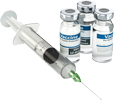



 View paper
View paper
 Go to abstract
Go to abstract
